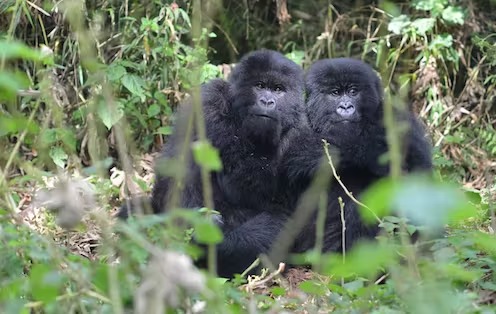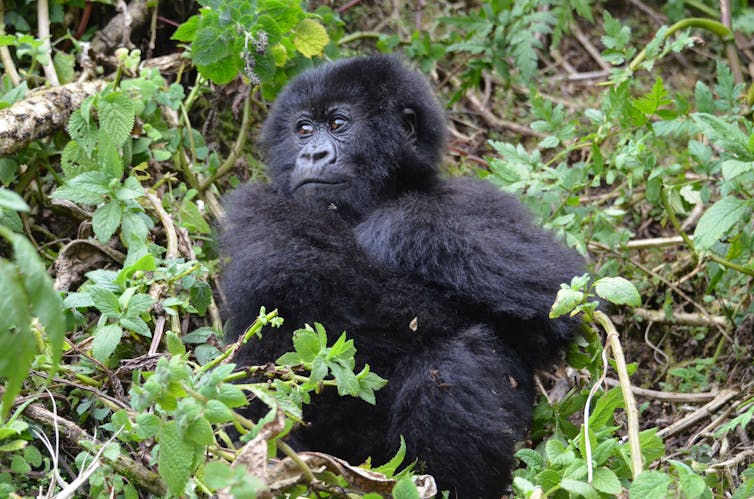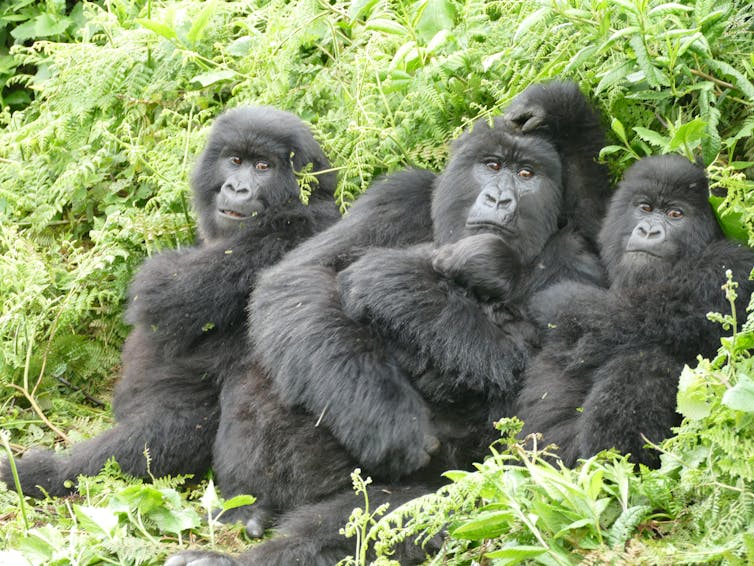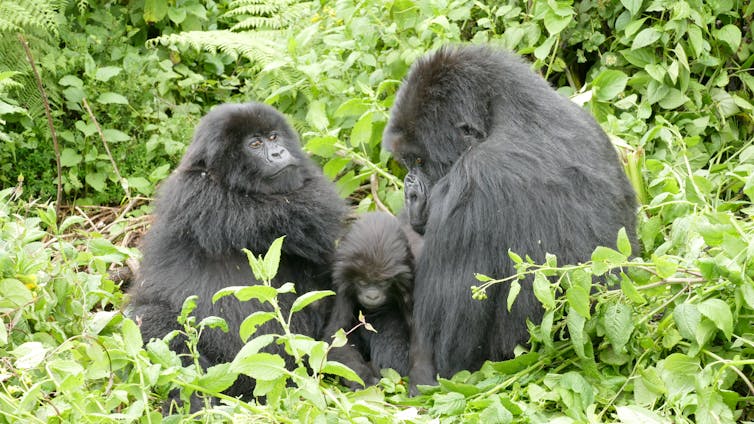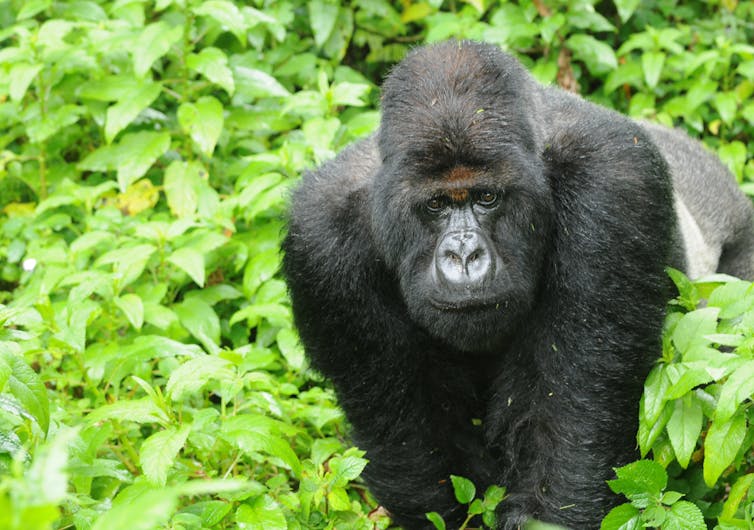In 1974, an infant mountain gorilla was born in Volcanoes National Park in Rwanda. Researchers named him Titus. As is typical for young gorillas in the wild, Titus spent the first years of his life surrounded by his mother, father and siblings, as well as more distant relatives and unrelated gorillas that made up his social group.
In 1978, however, tragedy struck. Poachers killed Titus’ father and brother. In the chaos that followed, his younger sister was killed by another gorilla, and his mother and older sister fled the group. Juvenile Titus, who was at a developmental stage similar to that of an 8- or 9-year-old human, experienced more tragedy in his first four years of life than many animals do in a lifetime.
In people, a rough start in life is often associated with significant problems later on. Early life adversity can take a wide variety of forms, including malnutrition, war and abuse. People who experience these kinds of traumas, assuming they survive the initial event, are more likely to suffer health problems and social dysfunction in adulthood and to have shorter life spans. Often, these outcomes trace back at least in part to what public health researchers call health risk behaviors – things like smoking, poor eating habits and a sedentary lifestyle.
But researchers have documented the same kinds of problems in adulthood in nonhuman animals that experienced early life adversity. For example, female baboons who have the hardest childhoods have life spans that are on average only half as long as their peers that have the easiest. Activities like smoking and unhealthy food choices can’t be the whole story, then, since animals don’t engage in typical human health risk behaviors.
Given the connection between adverse events while young and poor health later in life, one might expect that Titus’ unlucky early years would predict a short, unhealthy adulthood for him. However, there are interesting hints that things might work differently in mountain gorillas, which are one of humans’ closest living relatives.
Researchers analyzed decades of observational data to determine how life turned out for young gorillas that had faced adversity. Dian Fossey Gorilla Fund
Decades of gorilla observations
As scientists who have spent many years studying wild gorillas, we have observed a wide variety of early life experiences and an equally wide variety of adult health outcomes in these great apes. Unlike other primates, mountain gorillas don’t appear to suffer any long-term negative effects of losing their mothers at an early age, provided that they reach the age at which they are old enough to have finished nursing.
Losing your mother is only one of many bad things that can happen to a young gorilla, though. We wanted to investigate whether a pattern of resilience was more generalized. If so, could we gather any insight into the fundamental question of how early life experiences can have long-lasting effects?
To do this, we needed exceptionally detailed long-term data on wild gorillas across their lifetimes. This is no mean feat, given gorillas’ long life spans. Primatologists know that males can survive into their late 30s and females into their mid-40s.
The best data in the world to conduct such a study comes from the Dian Fossey Gorilla Fund, which has been following individual mountain gorillas in Rwanda almost daily for 55 years. We conducted doctoral and postdoctoral research with the Fossey Fund and have collaborated with other scientists there for more than 20 years.
From their database, which stretches back to 1967, we extracted information on more than 250 gorillas tracked from the day they were born to the day they died or left the study area.
We used this data to identify six adverse events that gorillas younger than age 6 can endure: maternal loss, paternal loss, extreme violence, social isolation, social instability and sibling competition. These experiences are the gorilla equivalent of some kinds of adversity that are linked with long-term negative effects in humans and other animals.
Many young gorillas didn’t survive these challenges. This is a strong indication that these experiences were indeed adverse from the perspective of a gorilla.
Ubufatanye experienced the loss of her mother and father and the disintegration of her family group before the age of 5. Now 20, she has become a successful mother, raising three offspring. Dian Fossey Gorilla Fund
We were surprised to discover, however, that most of the repercussions of these hardships were confined to early life: animals that survived past the age of 6 did not have the shorter life spans commonly associated with early life adversity in other species.
In fact, gorillas that experienced three or more forms of adversity actually had better survival outcomes, with a 70% reduction in the risk of death across their adult years. Part of this hardiness, especially for males, may be due to a phenomenon called viability selection: Only the strongest animals survive early adversity, and thus they are also the animals with the longest life spans.
While viability selection may be part of the story, the patterns in our data strongly suggest that as a species, mountain gorillas are also remarkably resilient to early adversity.
Where do gorillas get their resilience?
Although our findings corroborate previous research on maternal loss in gorillas, they contrast with other studies on early adversity in humans and other long-lived mammals. Our study indicates that the negative later-life consequences of early adversity are not universal.
The absence of this connection in one of our closest relatives suggests there might be protective mechanisms that help build resiliency to early-life knocks. Gorillas may provide valuable clues to understand how early life experiences have such far-reaching effects and how people can potentially overcome them.
Young gorillas live with their parents as part of larger social groups. Dian Fossey Gorilla Fund
While there is still much left to explore, we suspect that gorillas’ food-rich habitat and cohesive social groups could underpin their resiliency. When young gorillas lose their mothers, other social group members fill in the companionship hole she leaves behind. Something similar may happen for other types of early adversity as well. A supportive social network combined with plentiful food may help a young gorilla push through challenges.
This possibility underscores the importance of ensuring that human children who experience early adversity are supported in multiple ways: socially, but also economically, especially since early adversity is particularly prevalent among children living in poverty – itself a form of adversity.
Titus, pictured here as an adult, survived more adversity before age 4 than many animals confront in a lifetime. Dian Fossey Gorilla Fund
And what became of Titus? Despite his difficult start in life, Titus went on to lead his group for two decades, siring at least 13 offspring and surviving to his 35th birthday, making him one of the most successful gorillas the Dian Fossey Gorilla Fund has ever studied.
Though Titus’ story is only a single anecdote, it turns out that his resilience is not so unusual for a member of his species.



 Thousands of satellites are due to burn up in the atmosphere every year – damaging the ozone layer and changing the climate
Thousands of satellites are due to burn up in the atmosphere every year – damaging the ozone layer and changing the climate  Burkina Faso and Mali’s fabulous flora: new plant life record released
Burkina Faso and Mali’s fabulous flora: new plant life record released  GesiaPlatform Launches Carbon-Neutral Lifestyle App ‘Net Zero Heroes’
GesiaPlatform Launches Carbon-Neutral Lifestyle App ‘Net Zero Heroes’  The UK is surprisingly short of water – but more reservoirs aren’t the answer
The UK is surprisingly short of water – but more reservoirs aren’t the answer  How America courted increasingly destructive wildfires − and what that means for protecting homes today
How America courted increasingly destructive wildfires − and what that means for protecting homes today  Parasites are ecological dark matter – and they need protecting
Parasites are ecological dark matter – and they need protecting  Drug pollution in water is making salmon take more risks – new research
Drug pollution in water is making salmon take more risks – new research  How to create a thriving forest, not box-checking ‘tree cover’
How to create a thriving forest, not box-checking ‘tree cover’  Fertile land for growing vegetables is at risk — but a scientific discovery could turn the tide
Fertile land for growing vegetables is at risk — but a scientific discovery could turn the tide  Extreme heat, flooding, wildfires – Colorado’s formerly incarcerated people on the hazards they faced behind bars
Extreme heat, flooding, wildfires – Colorado’s formerly incarcerated people on the hazards they faced behind bars  As the Black Summer megafires neared, people rallied to save wildlife and domestic animals. But it came at a real cost
As the Black Summer megafires neared, people rallied to save wildlife and domestic animals. But it came at a real cost  Fungi are among the planet’s most important organisms — yet they continue to be overlooked in conservation strategies
Fungi are among the planet’s most important organisms — yet they continue to be overlooked in conservation strategies 










